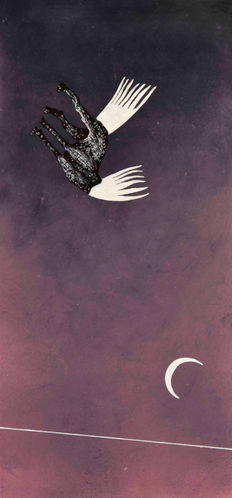Fifteen Cubits Upward Did the Waters Prevail
Binyamain Gallery, TLV 2025
Curator: Shlomit Liver
In this exhibition, whose name is taken from Genesis, Chapter 7, Doron Fishbein uses the biblical flood story
as a filter through to observe the “Israeli reality.” In the story, God decides to bring a flood and destroy all
humankind except Noah and his household, for “the wickedness of man was great in the earth, and ... every
imagining of the thoughts of his heart was only evil continually.” (Genesis 6:5 Fishbein looks around himself,
sees our miserable reality, and contemplates the possibility that the story did not end how they told us. “The
flood is still with us,” he says, “the flood hasn‟t ended yet. The dove has not yet been sent on its mission; the
olive leaf is not yet in its mouth.”
The video work Raven’s Commentary resembles a report from the raven that returned to Noah and
chronicled its findings. Segments of images and sound are welded together in the work: a woman‟s voice
recites Johann Wolfgang von Goethe‟s poem The Sorcerer’s Apprentice in German; birds fly frantically; a
lightbulb flickers; warplanes cut across the sky; and a very blond woman, a shiksa, smiles seductively as a
white liquid pours down from the top of the frame. Is it semen, or perhaps blood? In the work, Middle
Eastern elements – such as music and architecture as well as fireworks, maybe from Yom Haatzmaut – are
juxtaposed alongside the German language. The images elicit discomfort, evoke war‟s threats, and bring to
the surface memories of the Holocaust. The poem‟s plot infuses the work with additional meanings. The
sorcerer‟s apprentice puts a spell on the broom to help him execute the cleaning chores the sorcerer has
assigned him. He puts a spell on the broom to bring water from the well but cannot undo the spell and stop
its charm. The broom brings more and more water, until it overflows and floods everything. Unlike the
biblical story, the torrent or “flood” in the poem does not result from divine intervention, but rather from the
hubris of the apprentice, who exercises powers he is unable to control. This story is painfully relevant today.
The lion‟s share of the exhibit is comprised of dozens of works on paper. “These paintings represent a
process that extended over many years, of dealing with the tensions, fears, and threats I experience due to
the „Israeli reality,‟” the artist relates. A subjective reality unfolds on the page with varying degrees of
symbolism and abstraction. Symbols from Fishbein‟s own personal mythology, conveying threats and
danger, appear alongside representations of pervert sexuality and morbid images. He does not address
Israeli reality concretely. The appearance and style create detachment, and transmit a sense of another,
faraway place. Yet, hints pointing to the local context are planted throughout the works: cacti; Middle
Eastern architectural elements; and fish, which for the artist designate the beaches of Jaffa, the city of his
birth.
A two-person portrait of the artist and his partner hang in the gallery‟s entrance. Their faces are covered by
black and white stripes, a recurring motif for Fishbein which symbolizes an obscure threat. The work
addresses the mystery at the foundation of the relationship between couples, and the fears inherent in this
connection. Like a contemporary version of Noah and his wife, Doron and his partner welcome guests to the
gallery, their ark, or to some chamber of wonders/horrors replete with danger, disgust, and beauty.

Fishbein























